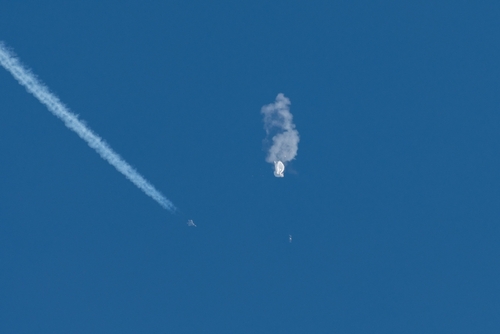In February 2023, a Chinese high-altitude surveillance balloon was detected traversing U.S. airspace, triggering diplomatic tensions. After tracking it across multiple states, the U.S. military shot it down off the South Carolina coast. China claimed it was a weather research airship. The mysterious journey of a Chinese spy balloon across U.S. skies has intensified debates on national security and defense readiness under former President Joe Biden.
Incident Overview
In 2023, this Chinese spy balloon journeyed across the United States, equipped with sophisticated U.S. technology. This unexpected intrusion raised alarm over national defense strategies. Sources indicate the balloon entered U.S. airspace over Alaska, making its way to Montana, where a newspaper photographer took the first public image. The balloon’s presence, initially concealed, endangered national security as it traversed several military installations before being neutralized over the Atlantic.
Chinese spy balloon that traversed US airspace was packed with American tech: report https://t.co/dSRTQo4Tsg pic.twitter.com/Wk8DSZmeV7
— New York Post (@nypost) February 11, 2025
Despite being aware of the threat, the Biden administration refrained from immediate public disclosure. Officials, including former President Biden and General Milley, allegedly prioritized learning from the balloon, seeking to understand its technology and origin. Reports indicated self-destruct mechanisms within the balloon, underscoring the potential dangers against compromised surveilled sites.
Implications for National Security
Questions surrounding the Biden administration’s handling of the balloon incident abound, explicitly focusing on the response undertaken by top military officials. As reported, a strategic call between Gen. Glen VanHerck and Gen. Mark Milley on January 27 marked the start of an eight-day response period. Such a duration has prompted scrutiny over the adequacy and timeliness of defense protocols to mitigate this threat. Each decision, from detection to eventual downing of the balloon, speaks to readiness and surveillance challenges.
Whatever happened to the investigation into the Chinese Spy Balloon ?? pic.twitter.com/OaRdjLDm87
— Diane Jackson🇺🇸🦅🇺🇸 (@Diane_Jackson7) February 11, 2025
“On a Friday evening last January, Gen. Glen VanHerck, the Air Force commander in charge of defending American airspace from intrusion, called President Joe Biden’s top military adviser, Gen. Mark Milley.”
Military installations beneath the balloon’s path reiterate the urgency for refined airspace monitoring systems. With tensions between the U.S. and China already high, this intrusion further complicates diplomatic relations. The incident raises broader concerns over cybersecurity, surveillance, and technological advances at foreign nations’ disposal.
Public and Political Reactions
The administration’s choice to initially withhold information from the public, including the Gang of Eight Congressional leaders, faces intense critique. Transparency remains a key aspect of public trust in government, especially concerning defense matters. The incident elicited widespread demands for clarity and efficiency in managing foreign intelligence threats.
“Before it was spotted publicly, there was the intention to study it and let it pass over and not ever tell anyone about it.” – a former senior U.S. official.
Critics argue the Biden administration may have underestimated the gravity of such intelligence operations, emphasizing the need for an immediate proactive stance. National security remains paramount, demanding robust systems that instantly recognize and address aerial threats like the Chinese spy balloon.
Sources:
https://www.thegatewaypundit.com/2025/02/chinese-spy-balloon-joe-biden-allowed-traverse-us/
https://www.thegatewaypundit.com/2025/02/chinese-spy-balloon-joe-biden-allowed-traverse-us/
https://www.thegatewaypundit.com/2025/02/chinese-spy-balloon-joe-biden-allowed-traverse-us/
